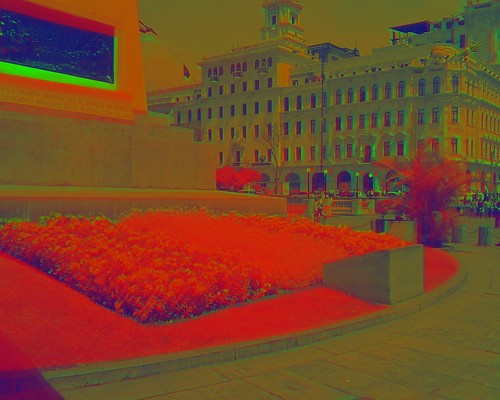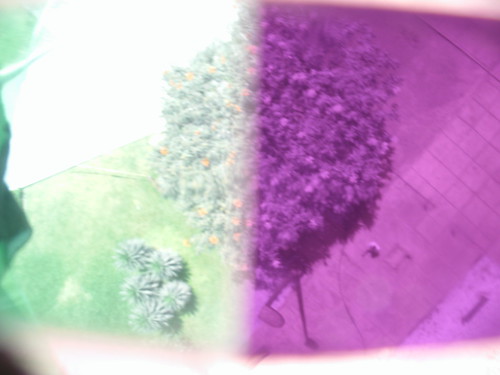We've been modifying cheap cameras to take infrared (IR) photos. Though we cannot perceive it with our eyes the plants and other materials around us reflect wavelengths of light in infrared. Interestingly the sensors in digital camera can react to wavelengths of light in the near infrared. Presently IR light is filtered out from our cameras so that digital images look normal to us. Removing that filter allows us to pickup information in IR using a digital camera (Caution is required to remove this filter! Please study up before trying any of this!).
 Taking photos with IR information can be used to generate NDVI (which stands Normalized Difference Vegetation Index) and for NRG images. NDVI and NRG are methods taking the information in pictures and quantifying the amounts of infrared and other wavelengths of light reflected from vegetation. This can be used to evaluate health of vegetation by comparing ratios of blue and red light absorbed versus green and IR light reflected. It's a snapshot of how much photosynthesis is happening. This is helpful in assessing vegetative health or stress. (Read more here: https://www.agronomy.org/publications/jeq/articles/36/3/832)
[Learn about NDVI images and how they work](/wiki/ndvi)
Learn to remove the infrared filter from your camera: https://www.flickr.com/photos/lpimaging/sets/72157625698391563/with/5355456142/
NDVI example:
Taking photos with IR information can be used to generate NDVI (which stands Normalized Difference Vegetation Index) and for NRG images. NDVI and NRG are methods taking the information in pictures and quantifying the amounts of infrared and other wavelengths of light reflected from vegetation. This can be used to evaluate health of vegetation by comparing ratios of blue and red light absorbed versus green and IR light reflected. It's a snapshot of how much photosynthesis is happening. This is helpful in assessing vegetative health or stress. (Read more here: https://www.agronomy.org/publications/jeq/articles/36/3/832)
[Learn about NDVI images and how they work](/wiki/ndvi)
Learn to remove the infrared filter from your camera: https://www.flickr.com/photos/lpimaging/sets/72157625698391563/with/5355456142/
NDVI example:
 NRG example:
NRG example:
 ##How to capture infrared and visible photographs##
By putting both an infrared-pass filter and an infrared-block filter on the same camera, you can get both infrared and visible light with one photograph... though the areas don't overlap. This means you can get such imagery from the air using [balloon mapping](/tool/balloon-mapping), while only risking one camera. Another alternative is to use the in-development [stereo camera](/tool/stereo-camera) being developed by the [New York City chapter](/place/new-york-city)
##How to capture infrared and visible photographs##
By putting both an infrared-pass filter and an infrared-block filter on the same camera, you can get both infrared and visible light with one photograph... though the areas don't overlap. This means you can get such imagery from the air using [balloon mapping](/tool/balloon-mapping), while only risking one camera. Another alternative is to use the in-development [stereo camera](/tool/stereo-camera) being developed by the [New York City chapter](/place/new-york-city)


 Taking photos with IR information can be used to generate NDVI (which stands Normalized Difference Vegetation Index) and for NRG images. NDVI and NRG are methods taking the information in pictures and quantifying the amounts of infrared and other wavelengths of light reflected from vegetation. This can be used to evaluate health of vegetation by comparing ratios of blue and red light absorbed versus green and IR light reflected. It's a snapshot of how much photosynthesis is happening. This is helpful in assessing vegetative health or stress. (Read more here: https://www.agronomy.org/publications/jeq/articles/36/3/832)
[Learn about NDVI images and how they work](/wiki/ndvi)
Learn to remove the infrared filter from your camera: https://www.flickr.com/photos/lpimaging/sets/72157625698391563/with/5355456142/
NDVI example:
Taking photos with IR information can be used to generate NDVI (which stands Normalized Difference Vegetation Index) and for NRG images. NDVI and NRG are methods taking the information in pictures and quantifying the amounts of infrared and other wavelengths of light reflected from vegetation. This can be used to evaluate health of vegetation by comparing ratios of blue and red light absorbed versus green and IR light reflected. It's a snapshot of how much photosynthesis is happening. This is helpful in assessing vegetative health or stress. (Read more here: https://www.agronomy.org/publications/jeq/articles/36/3/832)
[Learn about NDVI images and how they work](/wiki/ndvi)
Learn to remove the infrared filter from your camera: https://www.flickr.com/photos/lpimaging/sets/72157625698391563/with/5355456142/
NDVI example:
 NRG example:
NRG example:
 ##How to capture infrared and visible photographs##
By putting both an infrared-pass filter and an infrared-block filter on the same camera, you can get both infrared and visible light with one photograph... though the areas don't overlap. This means you can get such imagery from the air using [balloon mapping](/tool/balloon-mapping), while only risking one camera. Another alternative is to use the in-development [stereo camera](/tool/stereo-camera) being developed by the [New York City chapter](/place/new-york-city)
##How to capture infrared and visible photographs##
By putting both an infrared-pass filter and an infrared-block filter on the same camera, you can get both infrared and visible light with one photograph... though the areas don't overlap. This means you can get such imagery from the air using [balloon mapping](/tool/balloon-mapping), while only risking one camera. Another alternative is to use the in-development [stereo camera](/tool/stereo-camera) being developed by the [New York City chapter](/place/new-york-city)

